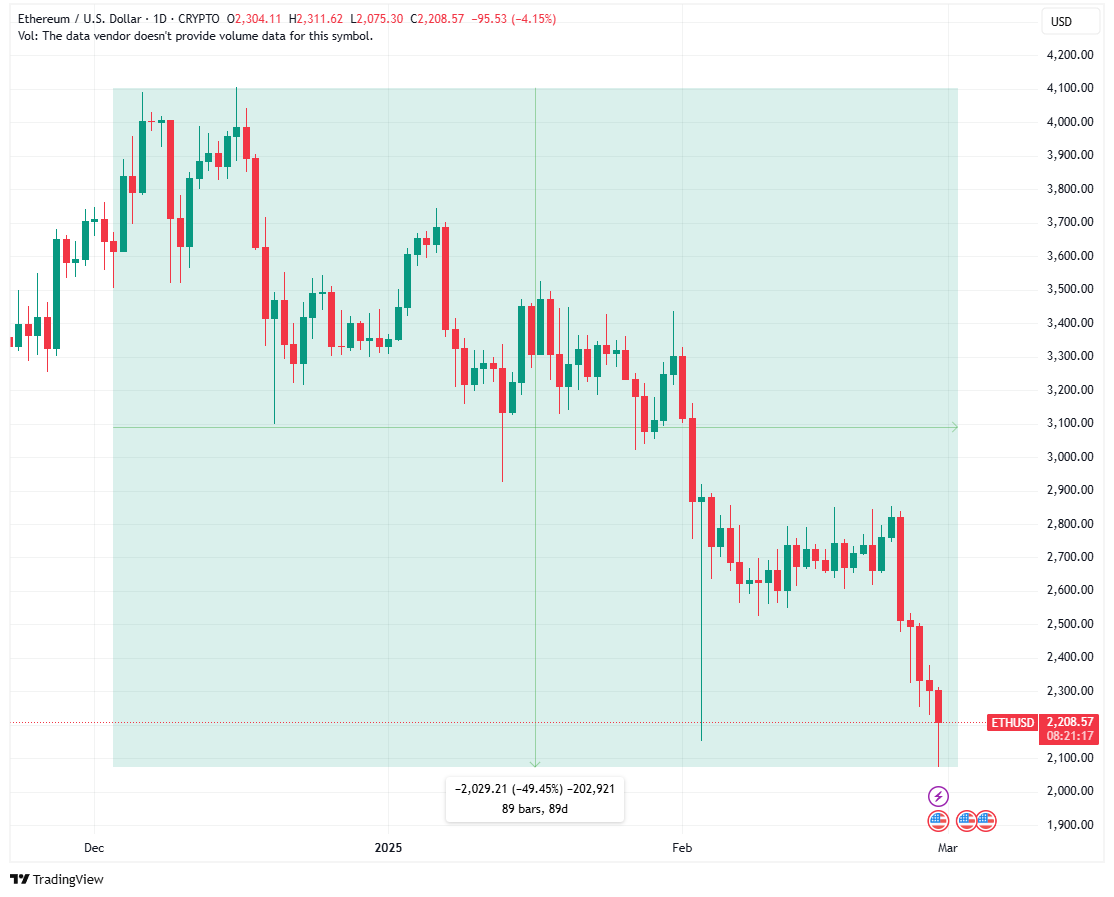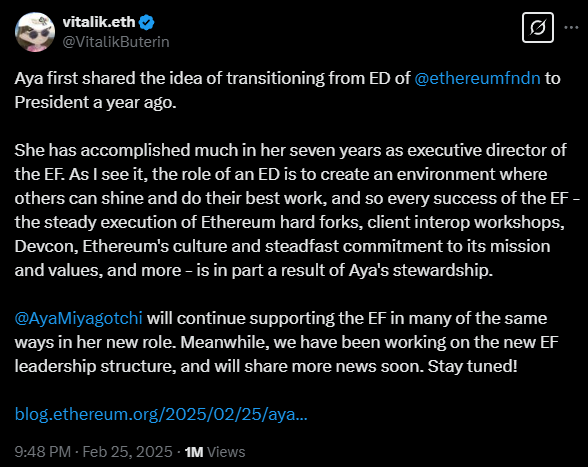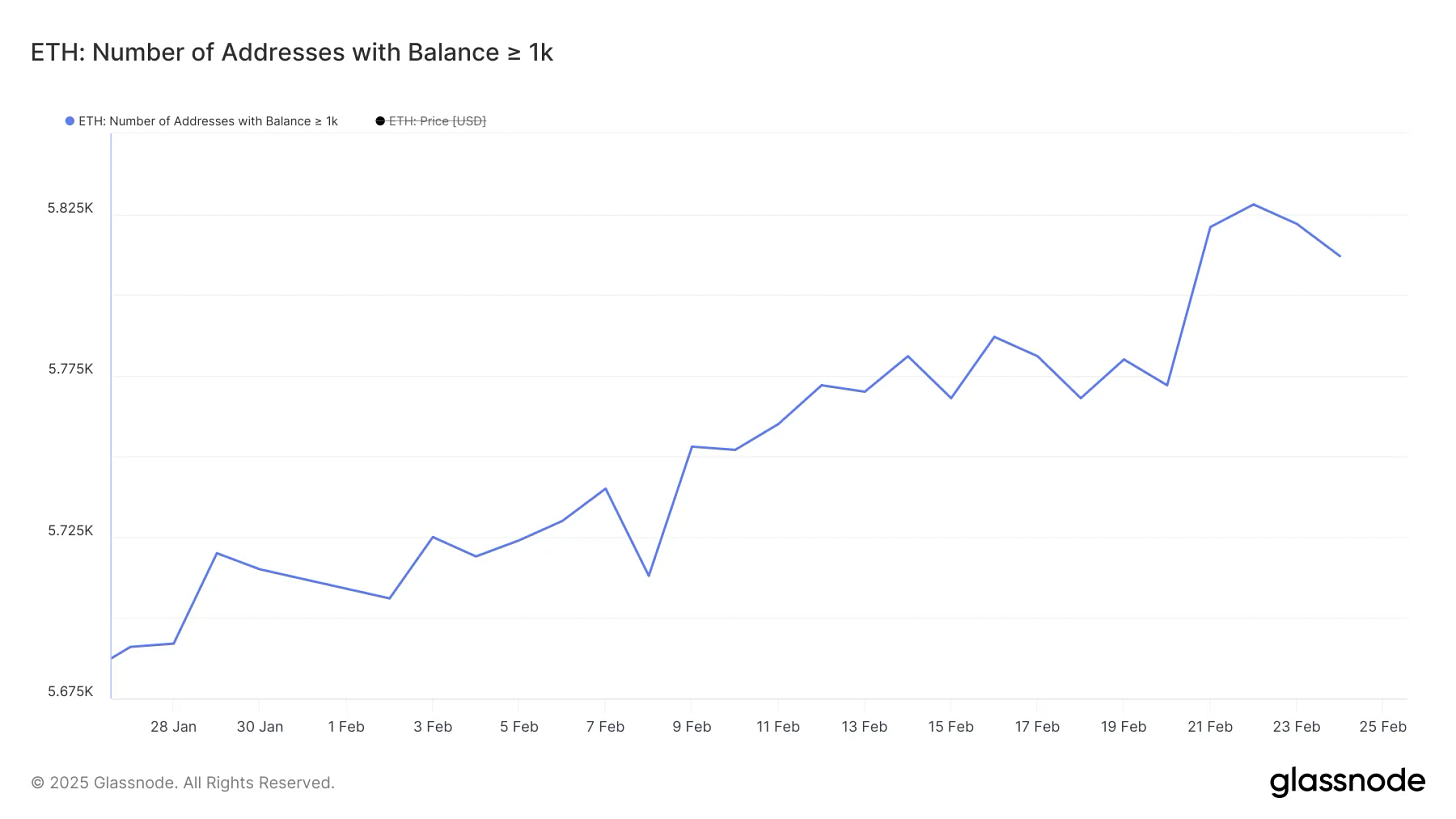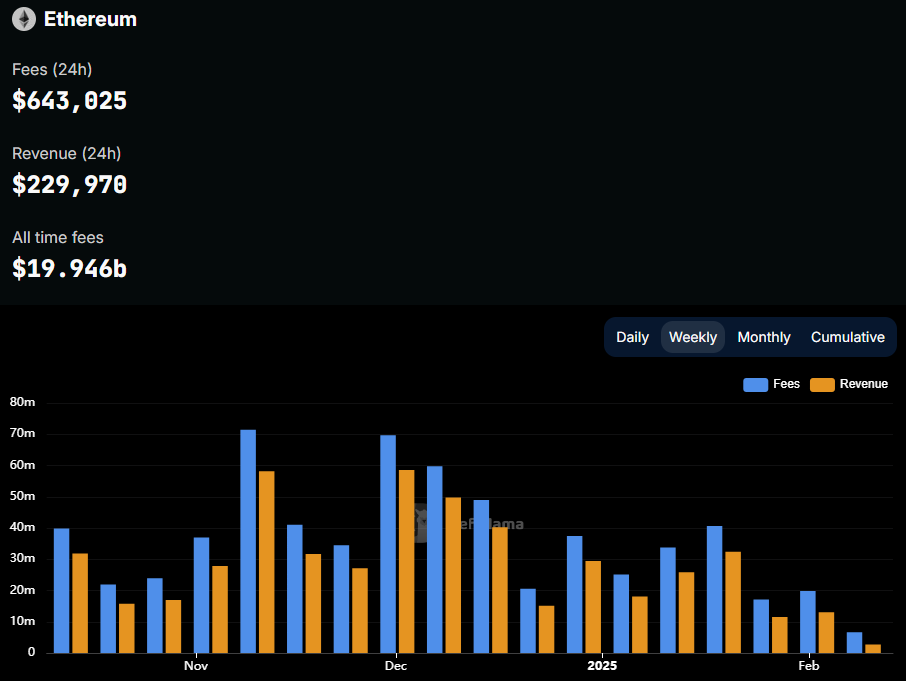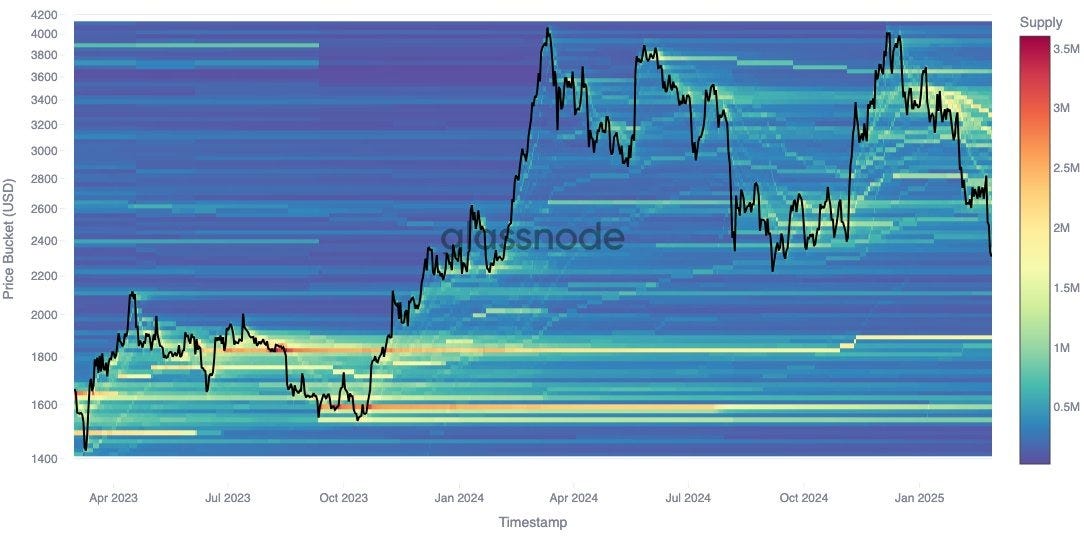Hello, y'all.
Yes, we know. Not a very happy Saturday to kick-off the weekend. Bitcoin has been giving y’all nightmares (if at all you are getting any sleep) with its dramatic slides.
We thought of a taking a break today and talk about its younger sibling - Ethereum.
The second largest cryptocurrency, and a dramatic parallel journey. Today’s deep-dive will feel like watching three different disaster movies playing simultaneously on the same screen.
First, there is Ethereum Foundation's (EF) leader stepping aside amid community backlash; then the developers frantically troubleshooting a failed upgrade; and finally $340 million in leveraged positions teetering on the edge of liquidation – all while ETH's price has nosedived 50% in three months.
In today's Wormhole, we examine whether this represents a fundamental shift in Ethereum's trajectory or simply another challenge for the resilient network to overcome.
Trade Smarter, Earn More – With Bitget Africa!
Crypto trading can be complicated. Maximising rewards while you trade? Even trickier.
Bitget Africa makes it easy with powerful tools, deep liquidity, and exclusive rewards— so you can trade with confidence.
Trade 500+ cryptocurrencies with ultra-low fees
Copy trade top investors and earn like the pros
Enjoy deep liquidity & advanced trading tools
Secure, user-friendly, and designed for all traders
Whether you're a beginner or a seasoned trader, Bitget Africa gives you the edge you need.
The best part? Get started in minutes—no complex setups, just seamless trading.
Start trading now & unlock your potential.
The Treble
Ethereum is navigating its most turbulent waters since The Merge — a leadership upheaval, technical failures, and market meltdown converging simultaneously.
Ethereum has lost almost half of its market cap over the past three months, briefly falling below $2,100 earlier this week — a level not seen since December 2023. Unlike other cryptocurrencies, though, ETH's struggles have been driven by internal fractures that have become impossible to ignore.
What brought us here? A lot of things — Aya Miyaguchi's controversial transition from Executive Director to President amid intense criticism, a failed Pectra upgrade on the Holesky testnet, and whales suddenly pausing their accumulation after reaching a one-year high.
Let’s dive into Ethereum's triple crisis and ask the question on everyone's mind: Is this the beginning of the end for the smart contract pioneer, or just another Tuesday in yet another uneventful year for Ethereum?
Get 17% discount on our annual plans and access our weekly premium features (HashedIn, Wormhole, Rabbit hole and Mempool) and subscribers only posts.
Leadership Crisis
The Ethereum community got a shocker this Tuesday when Executive Director Aya Miyaguchi announced she would be "stepping up" to the newly created role of President.
"These past few weeks have illuminated something profound about Ethereum. This new opportunity will allow me to continue supporting EF's institutional relationships, and to expand the reach of our vision and culture more broadly," Miyaguchi wrote, framing the transition as planned for over a year.
Reading between the lines tells a different story.
Calls for Miyaguchi's removal intensified in January after she appeared to reject a culture of competing and winning in a WIRED interview, just as Ethereum was losing ground to rival blockchains. Critics argued her leadership lacked the competitive edge needed in today's crypto landscape.
The backlash turned ugly.
Vitalik Buterin, Ethereum's co-founder, had to step in for damage control. He revealed that Miyaguchi faced harassment and death threats, forcing him to step in and assert that leadership changes remained his decision alone.
It was a bit too late though. Many community members had already rallied behind former EF researcher Danny Ryan, who led Ethereum's successful transition to proof-of-stake, as the ideal replacement.
Read: Ethereum's Leadership Crisis 🥶
This leadership turmoil comes at a vulnerable moment for Ethereum, with its price performance lagging behind competitors and development milestones facing delays.
The Foundation's structure itself has drawn criticism for its lack of transparency. Buterin promised a revamped leadership structure soon, but details remain scarce, until today, creating a governance vacuum precisely when decisive direction is most needed.
On Friday, the Ethereum Foundation unveiled its "Silviculture Society" – a new advisory group described as "a loose collection of individuals from outside the Foundation who provide informal counsel to the EF in tending to the (dark or otherwise) forests in the infinite garden of Ethereum."
The move appears to be part of the Foundation's response to criticism, adding external advisors while maintaining its metaphor-heavy, idealistic vision of Ethereum as an "infinite garden" rather than adopting the more aggressive corporate structure some community members have demanded.
Even though this might calm some nerves, there are more issues ETH is battling.
Whales Abandoning the Ship?
Ethereum's price chart shows a deteriorating market confidence.
After briefly touching $3,000 in early February, ETH has steadily declined, with the sell-off accelerating dramatically this past week. The 22% monthly drop leaves Ethereum trading at less than half its all-time high of $4,878 set three years ago.
What's driving the collapse? On-chain data reveals a troubling shift in whale behaviour.
The number of Ethereum whales — addresses holding at least 1,000 ETH — had been steadily increasing throughout January, reaching 5,828 on February 22, the highest level since February 2024. This upward trend abruptly reversed over the past few days, signalling that large holders have begun reducing their positions.
Meanwhile, institutional investors are actively hedging against further downside.
Thomas Erdösi, CF Benchmarks Head of Product, told The Block, "clear uptick in downside hedging interest" in CME Ethereum options, with particular focus on the $2,000 strike price.
An added concern for Ethereum's fundamental value proposition: transaction fees have plummeted 70%, hitting their lowest levels since 2020. The 7-day moving average fell to just $0.77 on February 15, down from $2.57 a week earlier.
While falling fees benefit users, this dramatic collapse suggests weakening demand rather than improved efficiency — a troubling sign for the network's overall health.
The Bybit Hack and Rollback Controversy
Ethereum's misery worsened with a $1.4 billion hack of Bybit's ETH reserves that sparked heated debates about blockchain immutability and governance.
The controversy began when several prominent figures suggested a potential "rollback" of the Ethereum blockchain to recover the stolen funds. This proposal met fierce backlash from the core development community, who emphasised that such action would undermine the fundamental principles of decentralisation.
The technical reality reinforces this point.
A true rollback would require reversing all transactions since the hack — disrupting DeFi protocols, liquidity pools, and every user who transacted during that period. This stands in stark contrast to the 2016 DAO incident, which involved an "irregular state change" before the hacker could move stolen funds, not a chain-wide reversion.
While Bybit has since recovered 84% of its reserves, the controversy exposed deeper tensions within the Ethereum ecosystem regarding governance and intervention.
Critics of Ethereum seized on this debate to question the network's commitment to immutability, even as most community members strongly rejected any rollback possibility.
Technical Failures Mounting
The leadership and market challenges collided with significant technical setbacks when Ethereum's highly anticipated Pectra upgrade failed to finalise on the Holesky testnet this Monday.
Pectra represents Ethereum's first major upgrade in almost a year, combining 11 significant improvement proposals (EIPs) that address critical user experience and staking limitations.
At its core, EIP-7702 aims to improve wallet functionality by adding smart contract capabilities, while EIP-7251 would allow validators to increase their maximum stake from 32 to 2,048 ETH.
This upgrade is crucial for Ethereum's competitive positioning, particularly as rival blockchains tout superior user experiences and scalability.
The failure on Holesky — reportedly due to misconfiguration in deposit contract addresses — raises serious concerns about Ethereum's development processes.
While testnet failures have occurred before — including during the Dencun upgrade in January 2024 — this setback couldn't come at a worse time.
The next test on Sepolia testnet, scheduled for March 5, may now face delays depending on the severity of the Holesky issues.
These technical challenges highlight a broader concern: as Ethereum attempts multiple ambitious improvements simultaneously, its execution capacity appears increasingly strained — precisely when flawless implementation is most needed to regain market confidence.
Silver Linings: Innovation Persists
Despite a pile of challenges, Ethereum's technical innovation continues beneath the turbulence.
On February 19, the Ethereum Foundation unveiled the Open Intents Framework, a new initiative developed in collaboration with Hyperlane and Bootnode to standardise "intent-based" transactions.
This framework addresses one of crypto's persistent usability challenges by allowing users to express desired outcomes — like "swap 1 ETH on Ethereum for as much DAI on Arbitrum as possible" — rather than submitting explicit step-by-step instructions for transactions.
"With the Open Intents Framework, we're taking a major step toward that reality —establishing shared standards for intent-based execution," explained Hart Lambur, co-founder of Risk Labs.
The framework has already secured support from leading Layer 2 networks, including Arbitrum, Polygon, Optimism, ZKsync, and Scroll — a promising sign of continued ecosystem collaboration despite governance tensions.
The Bull Case: Contrarian Opportunity?
Not everyone sees doom and gloom in Ethereum's current predicament. A contrarian perspective has emerged among some traders who view the sell-off as a potential buying opportunity.
Doctor Profit, an anonymous crypto analyst, recently expressed being "insanely bullish" on Ethereum based on its position relative to the 200-week EMA level. "The risk-reward here is outstanding! The potential move towards 8-10k is approx 200%, while the potential worst case is only 20%."
On-chain analysis from Glassnode points to a lower critical support level at $1,890. Their Cost Basis Distribution data reveals a massive accumulation zone of 1.82 million ETH at this price point — nearly 10% below current levels.
Between current prices and this major support zone lies only a thin accumulation level at $2,100, containing just 500,000 ETH—far less than the substantial support below it. This suggests limited buying pressure until the $1,890 level, where significant demand could emerge.
The taker buy-sell ratio — which highlights the volume of buy orders relative to sell orders — is rising for Ethereum while declining for Bitcoin. This divergence has previously signalled stronger bullish momentum for ETH in the short term.
For contrarian investors, this combination of strong technical support at $1,890, continued accumulation by long-term holders, and favourable buy-sell dynamics presents a compelling case that the current crisis may represent a generational buying opportunity rather than the beginning of a sustained decline.
For contrarian investors, the combination of oversold conditions, strong technical support, and continued development progress presents a compelling case that the current crisis may be overblown.
Token Dispatch View 🔍
Ethereum's storm of leadership turmoil, technical setbacks, and market collapse signals a fundamental identity crisis for the network that pioneered smart contracts and decentralised applications.
For years, Ethereum has positioned itself as technology-focused and mission-driven, prioritising technical excellence and philosophical purity over market positioning. The "infinite garden" metaphor reveals volumes about how the Foundation sees its role — as caretakers of an ecosystem rather than executives of a product.
This approach helped Ethereum revolutionise blockchain, but now faces its greatest test against market realities.
What stands about this crisis is how the different challenges amplify each other. Leadership uncertainty makes technical failures more concerning. Failed upgrades intensify market fears. Price declines put pressure on governance. It's a vicious cycle that's difficult to break without addressing all three dimensions simultaneously.
The newly-announced "Silviculture Society" perfectly illustrates Ethereum's dilemma. While adding external advisors is a step toward greater inclusion, the Foundation continues prioritising philosophical alignment over competitive drive — exactly when market participants are demanding more aggressive market positioning against Solana and other alternatives.
For investors, this divergence between Ethereum's self-identity and market expectations creates both risk and opportunity. The risk lies in further displacement if Ethereum cannot evolve its governance approach to match its technical ambitions. The opportunity emerges from the market potentially underestimating Ethereum's resilience and long-term value proposition amid short-term challenges.
Looking ahead, Ethereum faces a fundamental choice between doubling down on its decentralised, philosophical approach or embracing more decisive leadership and competitive positioning. Neither path guarantees success, but the current middle ground appears increasingly untenable.
The contrarian bull case has merit based on technical support, but Ethereum's sustainable recovery requires more than price action. It demands a coherent vision that bridges its philosophical roots with the aggressive execution the market now expects.
Those waiting for a clear signal to accumulate may need to look beyond price. Perhaps toward signs that Ethereum can resolve its governance paradox, successfully implement its technical roadmap, and articulate why it remains the preferred platform for builders in an increasingly competitive landscape.
Token Dispatch is a daily crypto newsletter handpicked and crafted with love by human bots. You can find all about us here 🙌
If you want to reach out to 200,000+ subscriber community of the Token Dispatch, you can explore the partnership opportunities with us.
Disclaimer: This newsletter contains sponsored content and affiliate links. All sponsored content is clearly marked. Opinions expressed by sponsors or in sponsored content are their own and do not necessarily reflect the views of this newsletter or its authors. We may receive compensation from featured products/services. Content is for informational purposes only, not financial advice. Trading crypto involves substantial risk - your capital is at risk. Do your own research.










